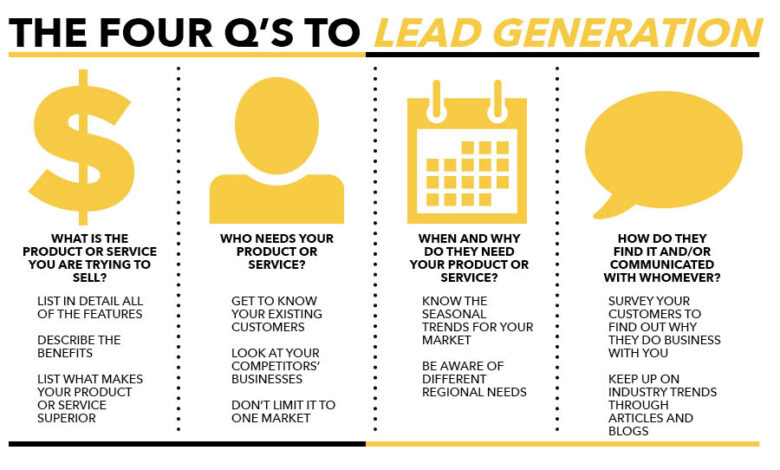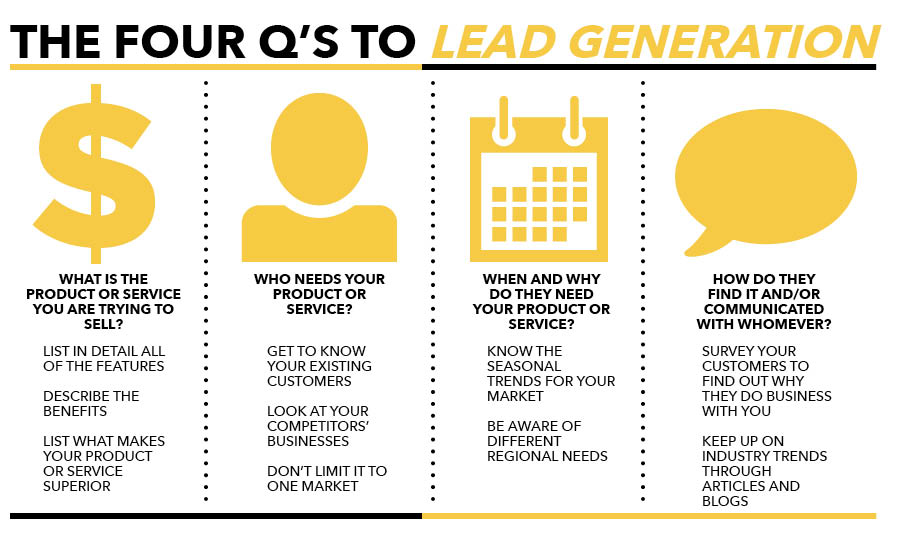
B2B Lead Generation Campaign A Comprehensive Guide
B2B lead generation campaign strategies are crucial for businesses looking to connect with potential clients. This guide dives deep into the entire process, from defining your objectives to executing and measuring your results. We’ll explore various approaches, including content marketing, webinars, and events, examining their strengths and weaknesses to help you choose the most effective methods for your specific business needs.
This in-depth guide will cover defining your target audience, crafting compelling messaging, and implementing effective lead nurturing strategies. We’ll also provide actionable insights on budgeting, campaign planning, and crucial performance tracking and analysis.
Defining the Campaign
A B2B lead generation campaign is a strategic initiative designed to attract and convert potential customers into qualified leads for a business-to-business (B2B) company. This process goes beyond simply gathering contact information; it’s about identifying and nurturing prospects who are most likely to become paying clients. Successful campaigns are meticulously planned and executed, focusing on understanding the target audience’s needs and pain points to deliver targeted messaging and valuable content.This involves more than just advertising; it’s about building relationships, establishing credibility, and demonstrating expertise within the industry.
It requires a deep understanding of the target audience, the buying process, and the specific objectives of the campaign. The goal is not just to generate leads, but to generate high-quality leads that are more likely to convert into paying customers.
Campaign Objectives and Target Audience
The primary objectives of a B2B lead generation campaign are typically focused on increasing brand awareness, generating qualified leads, nurturing leads through the sales funnel, and ultimately driving sales. Target audiences are carefully defined based on factors such as industry, company size, job title, and specific pain points or needs. Identifying the ideal customer profile (ICP) is crucial for optimizing campaign effectiveness.
For example, a SaaS company targeting small businesses might define their ICP as companies with 5-50 employees, needing project management tools to improve efficiency.
Stages in the B2B Lead Generation Process
The typical B2B lead generation process involves several distinct stages, each requiring specific strategies and tactics. These stages include awareness, consideration, decision, and action. The awareness stage involves creating content that educates and informs potential customers about the problem they are facing and the solution offered. The consideration stage focuses on providing in-depth information about the product or service, demonstrating its value proposition and competitive advantages.
The decision stage involves building trust and addressing any remaining concerns through testimonials, case studies, and personalized interactions. The final stage, action, involves closing the deal and onboarding the new customer.
Types of B2B Lead Generation Campaigns
Various methods can be employed to generate B2B leads, each with its own strengths and weaknesses. Content marketing, webinars, and events are common examples. Content marketing involves creating valuable and informative content, such as blog posts, articles, and ebooks, to attract and engage potential customers. Webinars offer an interactive platform for delivering educational content and demonstrating product capabilities to a targeted audience.
Industry events provide networking opportunities and allow businesses to showcase their products and services to potential clients face-to-face.
Comparison of Lead Generation Methods
| Lead Generation Method | Strengths | Weaknesses |
|---|---|---|
| Content Marketing | Builds long-term brand awareness and trust, cost-effective in the long run, improves ranking | Results can take time to materialize, requires consistent effort and planning |
| Webinars | Interactive and engaging, allows for direct interaction with potential clients, builds credibility | Requires significant planning and preparation, may not be suitable for all target audiences |
| Events | Provides face-to-face interaction, builds strong relationships, creates a sense of community | High cost associated with organizing and participating, limited reach compared to online methods |
Strategy & Planning

Defining a clear strategy is crucial for any successful B2B lead generation campaign. A well-defined plan ensures that efforts are focused and measurable, allowing for adjustments and optimization throughout the campaign lifecycle. This section delves into the key elements of a robust strategy, including goal setting, audience segmentation, channel selection, nurturing techniques, budgeting, and a structured execution framework.A well-structured plan allows for continuous monitoring and refinement.
This ensures that the campaign remains aligned with objectives and effectively targets the desired audience. Clear goals and metrics are essential for measuring progress and understanding the return on investment.
Defining Clear Goals and Metrics
Setting clear, measurable goals is paramount to the success of any lead generation campaign. These goals should be specific, quantifiable, achievable, relevant, and time-bound (SMART). For example, a goal might be to generate 50 qualified leads within the next quarter, or to increase the conversion rate from website visitors to leads by 15%. These specific targets provide a framework for tracking progress and evaluating campaign performance.
B2B lead generation campaigns need a strategic approach. A key element in crafting successful campaigns is understanding the intricacies of target audiences. For example, a strong digital marketing manager like marc babel digital marketing manager ctm can leverage their experience to effectively target and nurture potential clients, ultimately driving high-quality leads for your business. This ultimately leads to increased sales and better ROI for any B2B lead generation campaign.
Crucially, associated metrics must be defined to measure progress against these goals. These metrics should be closely tied to the overall business objectives.
My latest B2B lead generation campaign is really hitting the mark, and I’m excited about the results. It’s all about leveraging the latest features in social media platforms, like the recent breaking news on Facebook Messenger screen sharing. This new screen sharing capability is proving incredibly useful for demonstrating products and services in real-time, which is a massive boost for conversions.
Overall, I’m confident this innovative approach to B2B lead generation will continue to pay dividends.
Segmenting the Target Audience
Effective segmentation is key to maximizing campaign effectiveness. Instead of a broad approach, focusing on specific customer personas allows for tailored messaging and content. Identifying key demographics, psychographics, and buying behaviors of the target audience helps create targeted campaigns. For instance, a business might segment its audience by industry, company size, or job title to deliver relevant content.
This refined approach leads to more engaged prospects and a higher chance of conversion.
Choosing the Right Marketing Channels
Selecting the appropriate marketing channels is essential to reach the target audience effectively. A comprehensive approach should leverage a mix of channels that align with the campaign objectives and the target audience’s preferences. For instance, if the target audience is primarily active on LinkedIn, then a strong presence on this platform is essential. Other channels like industry-specific publications, webinars, and content marketing could also be crucial.
A thorough analysis of the target audience’s online behavior and preferences will guide channel selection.
Lead Nurturing Strategies
Lead nurturing is a critical aspect of converting prospects into paying customers. It involves engaging with leads at different stages of the sales funnel using targeted content and personalized communication. Examples of effective strategies include sending automated email sequences, providing valuable resources like ebooks or webinars, and engaging in targeted social media interactions. This sustained engagement builds trust and strengthens relationships with potential clients, leading to increased conversion rates.
Budgeting and Resource Allocation
A realistic budget is essential for a successful campaign. It should encompass all expenses, including marketing tools, personnel costs, advertising spend, and content creation. This requires careful planning to allocate resources effectively. For instance, if a campaign requires significant social media advertising, the budget should reflect this. A detailed breakdown of anticipated expenses and projected returns helps in strategic resource allocation.
Campaign Planning and Execution Framework
A structured framework ensures a systematic approach to campaign planning and execution. This framework includes clear steps, timelines, and responsibilities. This will help in identifying bottlenecks, optimizing workflows, and making informed decisions.
| Step | Description | Timeline | Responsible Party |
|---|---|---|---|
| 1. Define Goals and Metrics | Establish specific, measurable goals and metrics. | Week 1 | Marketing Team |
| 2. Segment Target Audience | Identify key demographics and buying behaviors. | Week 2 | Marketing Research Team |
| 3. Select Marketing Channels | Choose appropriate channels based on audience research. | Week 3 | Marketing Strategy Team |
| 4. Develop Lead Nurturing Strategies | Create targeted content and communication plans. | Week 4 | Content Creation Team |
| 5. Allocate Budget and Resources | Establish a realistic budget and resource plan. | Week 5 | Finance Team |
| 6. Implement and Monitor | Execute the campaign and track performance. | Ongoing | Marketing Team |
Content & Messaging
Crafting a compelling content strategy is crucial for any B2B lead generation campaign. Effective content not only attracts potential clients but also nurtures them through the sales funnel, ultimately driving qualified leads and conversions. This section delves into the vital aspects of content creation and messaging for B2B success.High-quality content acts as a powerful magnet for attracting and engaging potential customers.
It establishes credibility, showcases expertise, and positions your company as a thought leader within your industry. This, in turn, fosters trust and ultimately drives more profitable business relationships.
Importance of Valuable and Engaging Content
High-quality B2B content is essential for establishing thought leadership and building trust with potential clients. Engaging content demonstrates expertise, providing value to the target audience and positioning your company as a reliable source of information. This, in turn, fosters trust and drives conversions. It’s not just about filling the void with information, but creating content that resonates with the specific needs and pain points of your target audience.
Content Formats for B2B Lead Generation
Various content formats can effectively engage B2B audiences. Consider a mix of formats to cater to diverse preferences and learning styles.
- Blog Posts: These offer in-depth discussions on industry trends, challenges, and solutions. They establish your company as a thought leader and attract organic traffic.
- White Papers/Ebooks: These provide comprehensive, in-depth analysis of a specific topic. They can be used as lead magnets, generating valuable leads and nurturing prospects.
- Case Studies: Demonstrating success through real-world examples is highly effective in the B2B sector. These showcase tangible results and build trust.
- Webinars/Online Seminars: These offer interactive learning opportunities, allowing you to engage directly with potential customers. They can be used to build authority and establish a connection with your audience.
- Infographics: Visual representations of complex data or information can be highly engaging. They are a good choice for delivering complex concepts in a concise and digestible format.
Crafting Compelling Messaging
Compelling messaging is key to connecting with the target audience on an emotional level. It needs to address their specific needs and concerns.
- Focus on Benefits, Not Features: Instead of listing product specifications, highlight how the product or service solves the target audience’s problems and improves their outcomes.
- Use a Conversational Tone: Avoid jargon and technical terms. Speak directly to the audience, using language they understand.
- Tell Stories: Share real-life examples and experiences to make your message more relatable and memorable. Stories create an emotional connection.
- Address Specific Pain Points: Identify the key challenges your target audience faces and craft messaging that directly addresses these concerns.
Optimizing Content for Search Engines
Optimizing content for search engines () is crucial for driving organic traffic.
- Research: Identify the s and phrases your target audience uses when searching for information related to your industry.
- On-Page Optimization: Integrate relevant s naturally into your content, meta descriptions, and title tags.
- Off-Page Optimization: Build high-quality backlinks from reputable websites to improve your website’s authority and search engine rankings.
Best Practices for Content Marketing Tools
Effective use of content marketing tools can streamline and optimize the content creation process.
- Content Management Systems (CMS): These platforms offer a centralized hub for managing and publishing content.
- Social Media Management Tools: These help schedule and manage posts across various social media platforms.
- Analytics Tools: These provide insights into content performance and audience engagement.
Creating a Content Calendar
A content calendar ensures consistent content delivery.
- Planning Ahead: Plan topics and formats for upcoming weeks or months. This ensures a consistent stream of relevant content.
- Scheduling Posts: Use scheduling tools to publish content automatically on specific dates and times. This ensures timely content distribution.
- Tracking Performance: Monitor content performance using analytics tools and adjust the calendar accordingly.
Content Marketing Channels Effectiveness
| Channel | Effectiveness for B2B Leads |
|---|---|
| High – Ideal for networking, thought leadership, and generating leads. | |
| Industry-Specific Blogs/Forums | Medium – Helps connect with targeted audiences interested in your niche. |
| Email Marketing | High – Effective for nurturing leads and driving conversions. |
| White Papers/Case Studies | High – Provides valuable content to attract and qualify leads. |
| Webinars/Online Seminars | High – Offers interactive learning experiences and strengthens engagement. |
Execution & Measurement

Bringing a B2B lead generation campaign to life requires a meticulous execution plan, ensuring every step aligns with the defined strategy. This phase involves putting the blueprint into action, tracking progress, and adjusting the approach based on real-time data. Success hinges on meticulous monitoring and a willingness to adapt.
Implementing and Executing the Campaign, B2b lead generation campaign
The execution phase involves a phased rollout, ensuring gradual introduction of marketing materials and consistent messaging across all channels. This structured approach allows for adjustments and refinements based on initial responses. Key elements include:
- Campaign Launch: A formal launch event, whether online or offline, helps generate initial buzz and excitement. Consider using pre-launch announcements and teasers to build anticipation.
- Content Distribution: Targeted distribution of valuable content through relevant channels, such as social media, email marketing, and industry publications, is crucial. This involves establishing a consistent cadence to maintain engagement.
- Tracking and Monitoring: Implementation of tracking mechanisms to monitor campaign performance is paramount. This allows for real-time analysis and adaptation.
- Team Communication: Open communication channels between all team members involved in the campaign are essential for seamless execution and coordination.
Importance of Tracking and Monitoring
Tracking and monitoring campaign performance provides invaluable insights into the effectiveness of different strategies and channels. This data-driven approach enables informed decision-making, leading to optimal campaign adjustments and ultimately, higher conversion rates. By monitoring key metrics, businesses can identify strengths and weaknesses in their approach and tailor their efforts for better results.
Metrics for Measuring Success
Several key metrics are crucial for assessing the success of a B2B lead generation campaign. These metrics offer a comprehensive view of campaign performance, encompassing various aspects from awareness to conversion.
- Website Traffic: Analyzing website traffic allows businesses to understand the sources of visitors and the engagement levels on specific pages.
- Lead Generation Rate: The number of qualified leads generated is a direct measure of campaign effectiveness.
- Conversion Rate: This metric shows the percentage of leads that convert into paying customers, reflecting the campaign’s impact on sales.
- Customer Acquisition Cost (CAC): CAC reveals the cost of acquiring a new customer, providing insight into the campaign’s financial efficiency.
- Engagement Rate: The level of interaction with campaign content, such as clicks, shares, and comments, indicates audience interest and engagement.
Reporting and Analysis Tools
Utilizing reporting and analysis tools is vital for interpreting data and identifying areas for improvement. Tools like Google Analytics, HubSpot, and Salesforce provide comprehensive insights into campaign performance, allowing for informed decisions and adjustments.
- Google Analytics: Provides detailed website traffic data, including source, behavior, and conversion rates. It’s invaluable for understanding user journeys and identifying potential bottlenecks.
- HubSpot: Offers a suite of tools for marketing automation, CRM management, and reporting. It’s a powerful platform for managing and analyzing leads.
- Salesforce: Provides comprehensive CRM capabilities, offering insights into sales pipelines, lead nurturing, and customer relationship management. Its powerful reporting features are beneficial for campaign analysis.
Adapting the Campaign Based on Performance Data
Regular analysis of campaign performance data is crucial for adapting strategies and maximizing results. By identifying trends and patterns, businesses can optimize their approach, improving efficiency and achieving higher conversion rates.
- Identifying Underperforming Channels: Identifying channels that are not generating the desired results allows for reallocation of resources and a shift towards more effective approaches.
- Optimizing Content: Analyzing which content resonates most with the target audience enables creation of more engaging and impactful content.
- Adjusting Targeting: Understanding which segments of the target audience are most receptive to the campaign’s message enables a more precise approach.
Lead Generation Tools
Various tools can support lead generation efforts. Choosing the right tools depends on specific campaign needs and budget.
B2B lead generation campaigns need a strong online presence. Optimizing your Google Ads is key, and location extensions are often overlooked but hugely impactful. For example, using location extensions in your campaigns can dramatically increase click-through rates and conversions. Check out this insightful article on why location extensions have the largest impact on performance google ad extensions why location extensions have the largest impact on performance.
This kind of targeted approach is crucial for effectively reaching your ideal clients and driving leads in your B2B campaigns.
| Tool | Key Features |
|---|---|
| HubSpot | CRM, marketing automation, sales tools, and reporting. |
| Marketo | Marketing automation, lead nurturing, and segmentation capabilities. |
| ActiveCampaign | Email marketing, automation, and lead scoring. |
| Salesforce | Comprehensive CRM system with advanced analytics and reporting. |
Advanced Techniques
Taking your B2B lead generation to the next level requires more than basic strategies. Advanced techniques leverage sophisticated approaches, automation, and nuanced understanding of specific industries to cultivate high-quality leads. This involves recognizing the unique challenges and opportunities within various sectors and tailoring strategies accordingly. Effective execution requires meticulous planning, accurate measurement, and continuous optimization.
Advanced Lead Generation Strategies for Specific Industries
Different industries have unique needs and pain points. Tailoring lead generation strategies to these specifics is crucial for success. For example, a software company targeting enterprise clients will likely use different approaches than a small business offering marketing services. Understanding the nuances of each industry enables more effective targeting and messaging.
Examples of Successful B2B Lead Generation Campaigns in Various Industries
Numerous successful campaigns showcase the power of tailored strategies. One example is a healthcare technology company that targeted hospitals and clinics with personalized webinars and case studies demonstrating the efficiency gains of their software. Another example is a financial services firm that built a strong online presence, focusing on specific investor profiles and tailored content through a sophisticated lead nurturing program.
These campaigns demonstrate how a targeted approach can yield significant results.
The Role of Automation in Optimizing Lead Generation Efforts
Automation plays a pivotal role in scaling lead generation efforts. Tools like marketing automation platforms can automate repetitive tasks such as email sequences, lead scoring, and nurturing. This allows teams to focus on higher-value activities, such as developing more sophisticated strategies and engaging with qualified prospects.
Strategies for Generating Leads Through Events and Conferences
Events and conferences offer excellent opportunities for lead generation. Effective strategies include pre-event lead qualification, targeted booth design, and follow-up campaigns. Interactive demonstrations, exclusive content offers, and networking opportunities at conferences can lead to qualified prospects and high-conversion rates.
Utilizing Social Selling Techniques for B2B Lead Generation
Social selling involves leveraging social media platforms to connect with potential clients and build relationships. Effective strategies include identifying key influencers and thought leaders in your industry, actively participating in relevant conversations, and providing valuable content to build trust and credibility. Engaging with prospects on LinkedIn, for instance, allows for personalized interaction and builds rapport before a sales conversation.
Importance of Building Relationships with Potential Clients
Building relationships with potential clients is essential for long-term success. This involves understanding their needs, challenges, and goals. Regular communication, tailored solutions, and a focus on value creation can foster strong relationships and lead to loyal customers.
B2B Lead Scoring Models Comparison
| Lead Scoring Model | Description | Strengths | Weaknesses |
|---|---|---|---|
| Points-Based Model | Assigns points to various criteria like website activity, engagement, and demographics. | Easy to implement, quantifiable, and allows for customization. | Can become complex, may not accurately reflect overall prospect value. |
| Weighted Scoring Model | Assigns different weights to various criteria based on their importance. | More accurate reflection of lead quality, adaptable to different industries. | Requires careful consideration of weights, can be time-consuming to implement. |
| Probabilistic Model | Predicts the likelihood of a lead converting into a customer. | Provides a clear indication of conversion potential, helpful in prioritizing efforts. | Can be challenging to establish accurate probabilities, relies on historical data. |
This table provides a comparison of common B2B lead scoring models, highlighting their key features, strengths, and weaknesses. Choosing the right model depends on the specific needs and resources of the organization.
Case Studies & Examples
B2B lead generation is a complex process, requiring meticulous planning and execution. Case studies and examples offer valuable insights into what works and what doesn’t, allowing marketers to learn from both successes and failures. Analyzing past campaigns provides a crucial benchmark for future strategies, helping to identify effective approaches and avoid costly mistakes.
A Successful B2B Lead Generation Campaign
This campaign focused on a software solution for project management. The target audience was mid-sized construction companies. The strategy revolved around creating valuable content addressing common pain points within the industry. Lead magnets included a free project management template, a webinar on optimizing project schedules, and an e-book on using technology to streamline construction workflows.The campaign utilized targeted advertising on LinkedIn, engaging with relevant industry groups, and distributing content through email marketing.
A landing page was created to capture leads, and a CRM system was employed to manage interactions and nurture leads. The results were impressive. Conversion rates increased by 40%, and qualified leads grew by 50% over the previous quarter.
Different B2B Lead Magnets
Lead magnets are valuable resources offered in exchange for contact information. They serve as a crucial component in lead generation, providing value to potential customers while capturing their details. Different types of lead magnets cater to various needs and preferences.
- Free templates and checklists: These resources address practical issues and save time for potential customers. Examples include project management templates, sales process checklists, and social media content calendars. Their effectiveness lies in their practicality and direct application to common challenges.
- Webinars and online courses: These offer valuable insights and knowledge, positioning the company as a thought leader. Examples include webinars on industry trends, courses on specific software features, and tutorials on complex topics. Their effectiveness hinges on providing actionable advice and practical demonstrations.
- Ebooks and white papers: These offer in-depth information on specific topics, showcasing expertise and demonstrating a deep understanding of the industry. Examples include industry reports, analyses of market trends, and detailed explanations of complex processes. Their effectiveness stems from providing comprehensive knowledge and building credibility.
- Case studies and success stories: These demonstrate the positive impact of the product or service on other clients. Examples include client testimonials, before-and-after case studies, and demonstrations of specific use cases. Their effectiveness is rooted in showcasing tangible results and building trust.
Analyzing and Evaluating B2B Lead Generation Campaign Results
A critical aspect of any campaign is rigorous analysis of its effectiveness. Evaluation metrics should be clearly defined beforehand, providing a framework for tracking progress and measuring impact. These metrics encompass a variety of factors, from lead quality to conversion rates.
- Conversion rates: This metric measures the percentage of leads who convert into customers. It is calculated by dividing the number of conversions by the total number of leads.
- Lead quality: This refers to the likelihood of a lead becoming a customer. Factors include lead demographics, engagement level, and the lead’s demonstrated need for the product or service.
- Cost per lead (CPL): This metric measures the cost of acquiring a single lead. It is calculated by dividing the total marketing spend by the total number of leads generated.
- Customer acquisition cost (CAC): This metric measures the cost of acquiring a paying customer. It is calculated by dividing the total marketing spend by the number of new customers acquired.
A Failed B2B Lead Generation Campaign
A campaign focusing on a new cloud-based accounting software targeted small businesses. The lead magnet was a free trial, but the software’s interface was confusing, and the onboarding process was lengthy. The lack of clear communication on pricing and limited customer support led to a significant drop-off in trial conversions.
- Weaknesses: The software lacked usability, the lead magnet wasn’t aligned with customer needs, and inadequate customer support contributed to a negative user experience. The campaign lacked a clear understanding of the target audience’s pain points.
- Improvements: Focus on usability testing and feedback from potential customers. A more comprehensive onboarding process and readily available customer support. Create pricing tiers that cater to different business sizes. Clearly highlight the software’s benefits and value proposition in the marketing materials.
Key Takeaways from Various Case Studies
| Case Study | Key Takeaway |
|---|---|
| Campaign A | Focus on creating high-quality lead magnets. |
| Campaign B | Tailor content to the specific needs of the target audience. |
| Campaign C | Utilize a multi-channel approach for broader reach. |
| Campaign D | Continuously monitor and optimize the campaign based on results. |
Closing Summary: B2b Lead Generation Campaign
In conclusion, a successful B2B lead generation campaign requires careful planning, consistent execution, and a keen eye on performance metrics. By understanding the different stages involved, from defining your objectives to advanced techniques, you can build a robust strategy to attract and convert qualified leads into loyal customers. This guide offers a structured approach to navigate the complexities of B2B lead generation, equipping you with the knowledge and tools to achieve your business goals.





